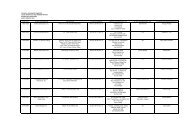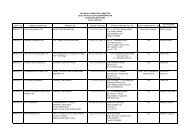Philippine National Standards for Drinking Water - LWUA
Philippine National Standards for Drinking Water - LWUA
Philippine National Standards for Drinking Water - LWUA
You also want an ePaper? Increase the reach of your titles
YUMPU automatically turns print PDFs into web optimized ePapers that Google loves.
Annex 3<br />
Guidelines <strong>for</strong> Selecting the Location of Sampling Points<br />
1. Sample Location<br />
1.1 Piped water supply zoning<br />
Zoning of piped water supplies should be undertaken to ensure that different<br />
parts of the water supply system that may have different level of risk are<br />
adequately covered <strong>for</strong> water quality sampling.<br />
A zone can be considered as coverage area per source, service reservoir<br />
supplies specific area , an area where different parts of distribution system<br />
operates at different pressures and elevations and an area where leakage or<br />
reliability is different in different parts of the system<br />
1.2 Point Source<br />
Samples should be taken from the point source from the principal outlet –<br />
handpump or spring outlet.<br />
For routine monitoring boreholes or deepwells generally requires less frequent<br />
sampling as they are usually of better quality than shallow groundwater given the<br />
greater depths of water abstraction.<br />
It is also important to undertake an extended assessment of point source quality<br />
in order to develop an understanding of the process causing water quality failure<br />
and thus the appropriate interventions required to improve the source.<br />
1.3 Selection of Sampling Sites<br />
When the sample locations and frequencies of sampling visits have been<br />
calculated, the final stage is the selection of sampling sites. Sample sites will<br />
usually be taken as being representative of a wider area. Samples sites can be<br />
either fixed – i.e. every time sampling is carried out in the area, a sample is<br />
always picked from the same point. Sample sites can also be random, with the<br />
exact location of the sample point in zone or area varying between sample<br />
rounds.<br />
1.3.1. Key fixed points that should always be included in the surveillance<br />
include:<br />
• water leaving treatment works (usually the first tap)<br />
• the inlets and outlets of service reservoirs<br />
• critical points in the distribution system - (e.g. low-pressure area<br />
or parts of the system prone to frequent discontinuity<br />
1.3.2. Regular sampling points will include public taps in high-density areas or<br />
in places such as markets where large number of people congregate.<br />
34







